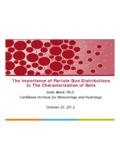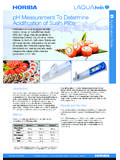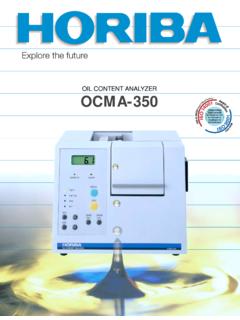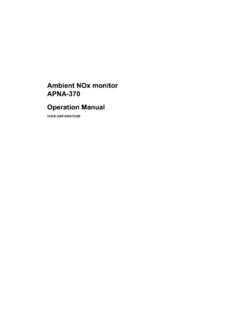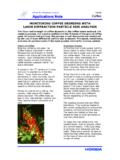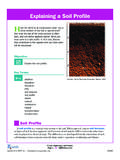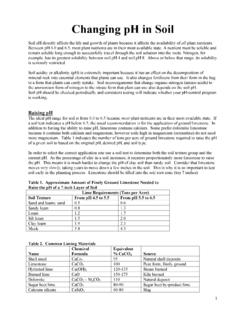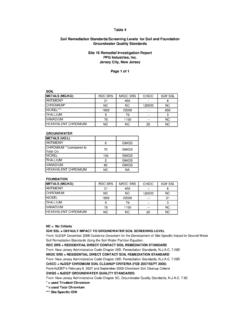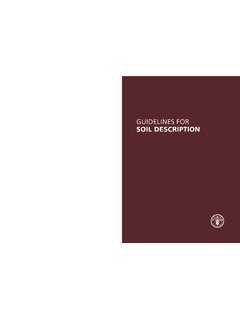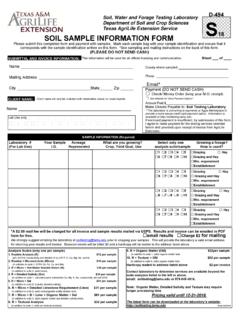Transcription of Soil pH and Nutrient Availability - Horiba
1 IntroductionSoil pH is a measure of the acidity or alkalinity in soils. In the pH scale, pH is neutral. Below is acidic and above is basic or alkaline. soil pH affects nutrients available for plant growth. In highly acidic soil , aluminum and manganese can become more available and more toxic to plant while calcium, phosphorus, and magnesium are less available to the plant. In highly alkaline soil , phosphorus and most micronutrients become less designing or planting new garden or landscape, it is helpful to check the soil pH as different plants thrive in different soil pH ranges. pH determination can give indication whether soil is suitable for the plants to be grown or it needs to be adjusted to produce optimum plant pH can be measured easily and inexpensively at home or on-site using LAQUA twin pH meters.
2 There are three (3) LAQUA twin pH meter models available, namely pH 11, 22, and 33. These pocket-sized compact meters allow two to five calibration points using either NIST or USA pH buffers. Among the above-mentioned models, the pH 33 meter has built-in temperature sensor that measures and displays temperature reading and automatic temperature compensation feature (ATC) that performs automatic calibration to the exact pH of the buffer at the measured temperature. Refer to the specifications of each meter model for more Calibrate the LAQUA twin pH meter according to manufacturer s instructions using at least two pH buffers that bracket the expected sample pH.
3 Sample Preparation And MeasurementThe method described below is based on US EPA Method 9045D. This is also applicable for measuring pH of waste samples, which may be solids, sludges, or non-aqueous liquids. If water is present, it must constitute less than 20% of the total volume of the Add 20ml of pure water to 20g sample in a beaker or container. Stir for 5 minutes then Let the soil suspension stand for about 1 hour. Alternatively, filter or centrifuge off the water Measure the pH of water phase. Record the pH value and the obtain accurate results, standard buffer solutions and samples should be measured at the same temperature. If the electrode is coated with oily material from a sample, clean it with detergent and warm water.
4 Application Note 07-2015 The desirable soil pH range for optimum plant growth varies among crops. Generally, soil pH is acceptable for most plants as most nutrients become available in this pH range. soil pH can be determined by mixing soil sample with water and then measuring the resulting aqueous pH and Nutrient AvailabilityContinued at the backSoil pHPlant Growth> alkaline for most plants7. 5 Iron Availability becomes a problem on alkaline soils7. to near to acceptable for most plants7. soil microbial activity< acid for most plants(Source: Colorado State University CMG Garden Notes #222)Continued from the frontIMSHORIBA Group is operating Integrated Management System (IMS)ISO9001 JOA-0298 / ISO14001 JOA-E-90039 / ISO13485 JOA-MD0010 / OHSAS18001 JOA-OH0068 Horiba Instruments (Singapore) Pte Ltd83 Science Park Drive, #02-02A, The Curie, Singapore 118258 Tel.
5 +65 6908 9660E-mail: and alkalinityCONDC onductivity and TDSNa+Sodium IonK+Potassium IonNO3 Nitrate IonCa2+Calcium IonSalt ECSalt (NaCl)LAQUA twin Pocket Ion Meter LineuppH Pocket Meter LineupmV2 p HMICRO VOLUMEp H 11mV3 pHMICRO VOLUMEpH 22 TempmV5 pHMICRO VOLUMEpH 33 FeaturesFlat pH sensor with automatic temperature compensation offers quick measurement of soils and waste samples Applications includeSoils, Solids, Sludges, Non-Aqueous liquids, and BenefitsThe desirable soil pH range for optimum plant growth varies among crops. Generally, soil pH is acceptable for most plants as most nutrients become available in this pH range. soil pH is important because it affects the Availability of nutrients to plants.
6 Nitrogen, phosphorus, and potassium are the primary nutrients needed in fairly large quantities. Calcium, magnesium, and sulfur are secondary nutrients required by the plant in lesser quantities. Zinc and manganese are micronutrients required by the plant in very small amounts. Most secondary and micronutrient deficiencies are easily corrected by keeping the soil at the optimum pH pH also affects activity of soil microorganisms. The population of bacteria that decompose organic matter declines and their activity is hindered in highly acidic soil , which results in accumulation of organic matter and the bound nutrients, particularly nitrogen.
7 Increasing soil pHApplying a material that contains some form of lime (calcium carbonate) like the ground agricultural limestone and wood ashes can increase the soil pH. The finer the limestone, the more rapid it becomes effective. Different soils will require a different amount of lime to adjust the soil pH. Wood ashes contain high amounts of potassium and calcium, and small amounts of phosphate, boron and other nutrients. Although not as effective as limestone, these can drastically increase the soil pH with repeated soil pHAside from ammonium-based fertilizers and organic matter, aluminum sulfate and sulfur are common materials used for decreasing soil pH.
8 Aluminum sulfate is preferred as it changes the soil pH as soon as it dissolves in the soil because of the aluminum. However, too much of this is toxic to plant. Sulfur takes some time to produce effect as it needs to be converted to sulfuric acid by soil acidicOptimum pH rangefor plant growthNitrogenPhosphorousPotassiumSulfur CalciumMagnesiumMajor Nutrient deficienciesTraceelementdeficienciesMoly bdenumIronManganese Boron Copper and ZincStrong alkalinityNeutralAlkalineSoil pH and Nutrient Availability (Source: Bluedale - )References And Suggested Readings1. US Environmental Protection Agency Method 9045D soil and Waste pH, Revision 4, November 20042.
9 Changing the pH of your soil . Clemson University Cooperative Extension. , 22 SEPTEMBER 2015pH H potatoRiceRosemarySageSoybeanApricotCher ryGrapevineGrapefruitHazelnutHopLemonLyc heeMulberryNectarinePeach PlumQuinceArtichokeBeanBeetrootBroccoliB russels sproutsCabbageCalabreseCeleryChinese cabbageChivesLettuceMilletMushroomMustar dOnionPeaPeppermintRadishSpinachBananaRh ubarbStrawberryRasberryCarrotCauliflower Sweet cornCucumberGarlicLentilParsleyPepperPum pkinShallotSpearmintThymeTomatoTurnipAvo cadoAsparagusGingerLeekMintPaprikaWaterc ress(Source: )
